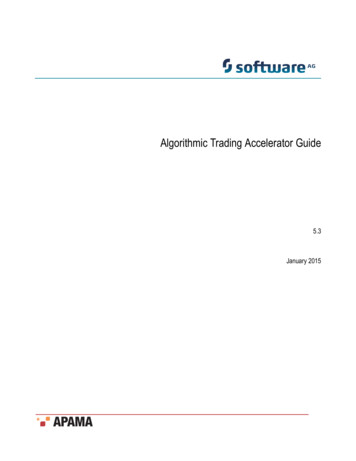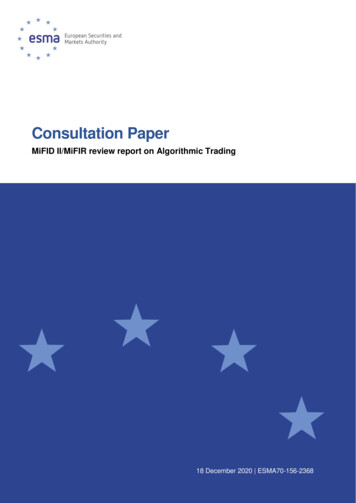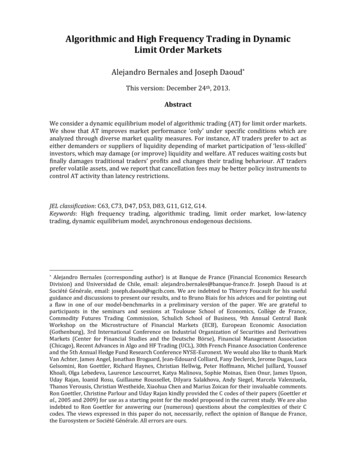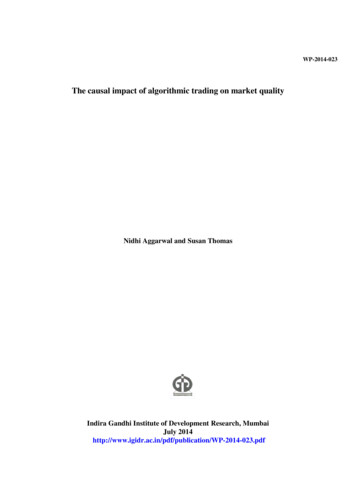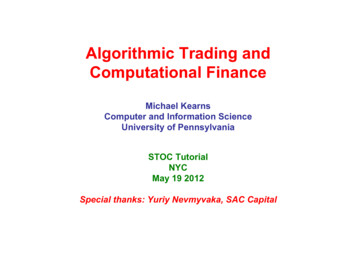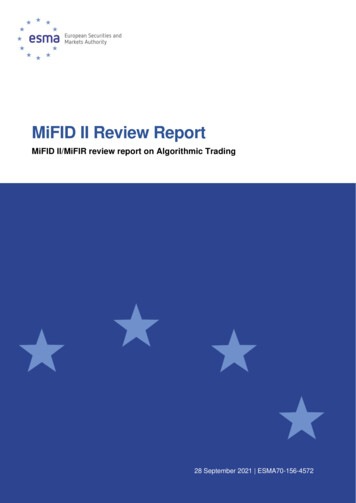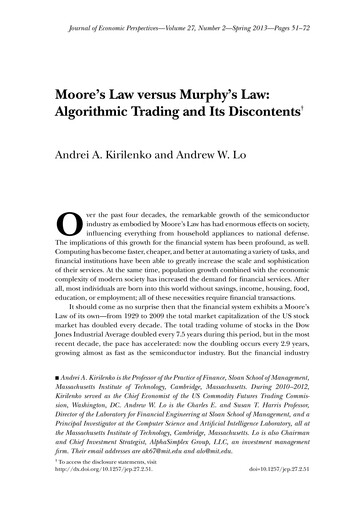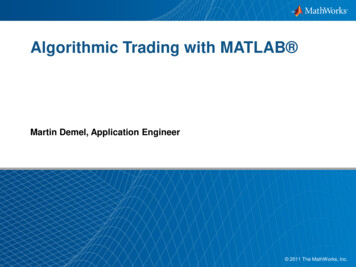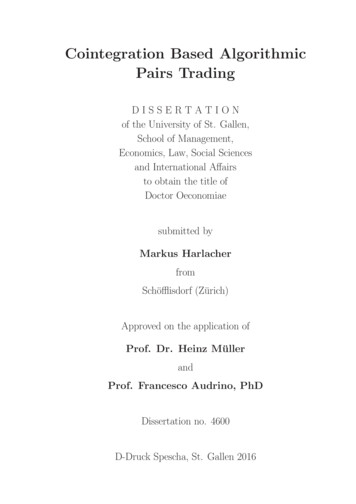
Transcription
Cointegration Based AlgorithmicPairs TradingDISSERTATIONof the University of St. Gallen,School of Management,Economics, Law, Social Sciencesand International Affairsto obtain the title ofDoctor Oeconomiaesubmitted byMarkus HarlacherfromSchöfflisdorf (Zürich)Approved on the application ofProf. Dr. Heinz MüllerandProf. Francesco Audrino, PhDDissertation no. 4600D-Druck Spescha, St. Gallen 2016
The University of St. Gallen, School of Management, Economics, Law, Social Sciences and International Affairs hereby consents to the printing of thepresent dissertation, without hereby expressing any opinion on the viewsherein expressed.St. Gallen, October 24, 2016The President:Prof. Dr. Thomas Bieger
To my family
CONTENTSvContentsNotationxiii1 Introduction1.1 The Contribution of Relative Value Investments1.2 The Asset Selection . . . . . . . . . . . . . . . .1.3 The Aim of this Analysis . . . . . . . . . . . . .1.4 The Structure of this Work . . . . . . . . . . . .2 A First Overview2.1 Literature Review . . . . . . . . . . . . . . . . . . . . .2.2 A Short Summary of the Presumably First PublishedTrading Approach . . . . . . . . . . . . . . . . . . . . .2.3 The Idea of Cointegration in Terms of Pairs Trading . .2.4 Pre-Selecting Securities . . . . . . . . . . . . . . . . . .2.5 The Question of Transforming Prices . . . . . . . . . . . . .Pairs. . . . . . . . . . . . .123457791114153 Price and Spread Generating Processes193.1 A Popular Price Process for Common Stocks . . . . . . . . . . 193.2 A Spread Process . . . . . . . . . . . . . . . . . . . . . . . . . 233.3 More General Processes . . . . . . . . . . . . . . . . . . . . . 264 Testing for Cointegration4.1 Preliminaries . . . . . . . . . . . . . . . . . .4.2 The Augmented Dickey-Fuller Unit Root Test4.3 The Phillips-Perron Unit Root Test . . . . . .4.4 The KPSS Stationarity Test . . . . . . . . . .4.5 The Phillips-Ouliaris Test . . . . . . . . . . .2930323638405 Test Analytics415.1 The Sensitivity and Specificity of Tests . . . . . . . . . . . . . 425.2 Test Performance under Different Price Dynamics . . . . . . . 436 Approaching the Multiple Testing Problem556.1 Highlighting the Problem . . . . . . . . . . . . . . . . . . . . . 556.2 A Simple Pre-Selection . . . . . . . . . . . . . . . . . . . . . . 57
viAbstract6.36.46.5A Heuristic Pre-Selection Based on Indexes .6.3.1 The Partitioning . . . . . . . . . . .6.3.2 Silhouettes for a Good Partition . . .6.3.3 Qualifications . . . . . . . . . . . . .The Common Trend Model . . . . . . . . .Risk Factors, Returns and Cointegration . .6.5.1 Risk Factors and Returns . . . . . .6.5.2 Risk Factors and Cointegration . . .7 Trading Rules and the Calculation of7.1 Pairs Formation and Trading Rule . .7.1.1 A Simple Trading Rule . . . .7.1.2 A Dynamic Trading Rule . . .7.2 Return Calculations . . . . . . . . . .Returns. . . . . . . . . . . . . . . . . . . . .8 Back-testing on the S&P 5008.1 The S&P 500 . . . . . . . . . . . . . . . . . . . .8.2 Strategy Implementation . . . . . . . . . . . . . .8.2.1 Fixed Index Grouping . . . . . . . . . . .8.2.2 Flexible Index Grouping . . . . . . . . . .8.2.3 Flexible Grouping Based on Fundamentals8.2.4 Summary of the Results . . . . . . . . . .8.3 Performance Measurement . . . . . . . . . . . . .8.4 Risk Measures . . . . . . . . . . . . . . . . . . . 249 Conclusion1339.1 Summary . . . . . . . . . . . . . . . . . . . . . . . . . . . . . 1339.2 Outlook . . . . . . . . . . . . . . . . . . . . . . . . . . . . . . 134Bibliography136A The Silhoutte Widths141B Trading Periods151
AbstractThis work analyses an algorithmic trading strategy based on cointegratedpairs of assets. The centrepiece of such a strategy is the discovery of tradablelinear combinations consisting of two or more financial assets. An intuitiveattempt to identify such linear asset combinations is based on statistical tests.An unrestricted testing of all possible linear combinations leads, however, toa multiple testing problem. Carrying out a sufficiently large number of testsalways gives significant results, even if not a single combination is truly cointegrated. This is in the nature of statistical tests. Well established correctionmethods like the popular Bonferroni correction turn out to be too conservative in such cases and make it impossible to discover even truly cointegratedcombinations that would be highly profitable if applied in the proposed investment strategy.A possible way to mitigate this problem can lie in the effective pre-partitioningof the considered asset universe with the purpose of reducing the number offeasible combinations and, therefore, the number of statistical tests, to combinations with an increased potential of being profitable. This is the main contribution of this dissertation. Besides analysing the robustness of establishedcointegration tests with respect to particular strategy-relevant features, themain focus lies on possible ways to pre-partition the overall set of admissibleassets. A carefully carried out back-testing finally inspects the effectivenessof the proposed methods.The back-testing results, which are based on an asset universe consistingof S&P 500 stocks and a time period stretching from January 1995 up toDecember 2011, show a very favourable picture. Apart from an attractiverate of return and a significantly smaller volatility as compared to the S&P500 index, the returns of the applied pairs-trading strategies showed only amarginal correlation with the overall market returns.vii
viiiZusammenfassung
ZusammenfassungIn dieser Arbeit wird eine algorithmische Anlagestrategie untersucht, dieauf paarweise cointegrierten Assets basiert. Das Kernstück solcher Strategien bildet das Auffinden von handelbaren Linearkombinationen aus mindestens zwei Assets. Ein intuitiver Ansatz, um solche Linearkombinationenaufzufinden, basiert auf statistischen Tests. Ein uneingeschränktes Testenaller möglichen Linearkombinationen führt jedoch zum Problem des multiplen Testens. So werden bei einer genügend grossen Anzahl Tests immersignifikante Resultate gefunden, auch wenn in Wahrheit keine einzige Kombination cointegriert ist. Dies liegt in der Natur statistischer Tests. BekannteKorrekturmethoden wie beispielsweise die häufig angewendete BonferroniKorrektur sind in solchen Fällen zu konservativ und verunmöglichen auch dasAuffinden von real cointegrierten Linearkombinationen, die für die Anlagestrategie äusserst profitabel wären. Ein möglicher Ansatz zur Linderung diesesProblems kann in einer wirkungsvollen Vorgruppierung des Anlageuniversumsliegen, um damit die Anzahl Kombinationsmöglichkeiten, und damit die Anzahl statistischer Tests, auf Kombinationen mit grossem Profitabilitätspotential zu reduzieren. Dies ist denn auch der Kern dieser Dissertation, die sichneben der Frage der Robustheit von bekannten Cointegrationstests in Bezugauf die für eine solche Anlagestrategie relevanten Eigenschaften vor allemmit möglichen Varianten der Vorselektion beschäftigt. Die Wirksamkeit dervorgeschlagenen Methoden wird anschliessend mit einem sorgfältig durchgeführten Back-Testing überprüft.Die Back-Testing-Resultate basierend auf einer Periode von Januar 1995 bisDezember 2011 und einem Anlageuniversum, das aus Aktien der im S&P 500Index geführten Unternehmen besteht, zeigen ein äusserst vielversprechendesBild. Neben einer ansprechenden Rendite und einer gegenüber dem S&P 500Index deutlich tieferen Volatilität besitzen solche Anlagestrategien auch nureine marginale Korrelation mit dem Gesamtmarkt.ix
xZusammenfassung
LIST OF FIGURESxiList of Figures3.13.2Geometric Brownian Motion: A typical sample path. . . . . .Ornstein-Uhlenbeck-process: A typical sample path. . . . . . .23274.14.2Distribution of the ADF/PP Teststatistic . . . . . . . . . . . .Distribution of the ADF/PP Test Statistic with and withoutConstant . . . . . . . . . . . . . . . . . . . . . . . . . . . . . 18.28.38.48.58.6Sensitivity / Specificity Plots according to a GBM Price Dynamics . . . . . . . . . . . . . . . . . . . . . . . . . . . . . . .Standard Deviation Dynamics under the Heston Model . . . .Price Process Dynamics under the Heston Model . . . . . . .Example: Spread-Returns with Heteroskedasticity . . . . . . .Example: Path with a Time-Varying AR-Coefficient . . . . . .Example: Spread-Returns with Time-Varying AR-Coefficient .Sensitivity / Specificity when AR Coefficient is Varying overTime . . . . . . . . . . . . . . . . . . . . . . . . . . . . . . . .3547484949505152Example of a Dendrogram . . . . . . . . . . . . . . . . . . . .A Silhouette Plot Example . . . . . . . . . . . . . . . . . . . .Correlation Structure between Industry Indexes . . . . . . . .Market Adjusted Correlation Structure between Industry Indexes . . . . . . . . . . . . . . . . . . . . . . . . . . . . . . . .Dependence Structure between Assets and underlaying Factors636566Example: Spread time series of a potential pair. . . . . . . . .Example: Spread time series of a fitted pair in the tradingperiod. . . . . . . . . . . . . . . . . . . . . . . . . . . . . . . .Example: Log-price series of a potential pair in the tradingperiod. . . . . . . . . . . . . . . . . . . . . . . . . . . . . . . .7981Fixed Index Grouping: No. of Pairs per Period and Industry.Fixed Index Grouping: No. of Pairs per Period. . . . . . . .Pairs Development per Industry in the 1st Period. . . . . . .Number of Transactions per Industry and Period. . . . . . .Number of Transactions per Period. . . . . . . . . . . . . . .Fixed Index Grouping: Value Development. . . . . . . . . .939495979899.677080
xiiLIST OF 188.198.208.218.228.238.24Fixed Index Grouping: Sub-Industry Value Development. . .Development of Telecom. Single Components in Period 14. .Flexible Index Grouping: No. of Groups per Period. . . . . .Flexible Index Grouping: No. of Pairs per Period. . . . . . .Flexible Index Grouping: No. of Transactions per Period. . .Flexible Index Grouping: Value Development. . . . . . . . .Correlation Structure between Fundamental Factors . . . . .Flexible Fundam. Grouping: No. of Groups per Period. . . .Flexible Fundam. Grouping: No. of Pairs per Period. . . . .Flexible Fundam. Grouping: No. of Transactions per Period.Flexible Fundamental Grouping: Value Development. . . . .Returns Volatility Plots. . . . . . . . . . . . . . . . . . . . .Comparison of the Value Development. . . . . . . . . . . . .Summary: Number of Transactions. . . . . . . . . . . . . . .Returns Dependence Plots. . . . . . . . . . . . . . . . . . . .Sample Mean Excess Plots. . . . . . . . . . . . . . . . . . .Shape Parameter ξ Robustness. . . . . . . . . . . . . . . . .Fitted Tails and Shortfall Estimates. . . . . . . . . . . . . 144145146147148149Indexes, Periods 1 to 8. . . . . .Indexes, Periods 9 to 16. . . . .Indexes, Periods 17 to 24. . . . .Indexes, Periods 25 to 32. . . . .Fundamentals, Periods 1 to 8. .Fundamentals, Periods 9 to 16. .Fundamentals, Periods 17 to 24.Fundamentals, Periods 25 to 32.
LIST OF TABLESxiiiList of Tables5.15.25.35.4The Sensitivity and Specificity of Statistical Tests. . . . . . . .Sensitivity / Specificity Quant. with GBM Price Dynamics. .Sensitivity / Specificity Quant. with Heston Price Dynamics. .Sensitivity / Specificity Quant. for Processes with Time-VaryingAR-Coefficient. . . . . . . . . . . . . . . . . . . . . . . . . . .4247506.1FTSE Industry Classification Benchmark. . . . . . . . . . . .588.18.28.38.48.58.68.78.8Telecommunication Pairs of Period 13. . . . . . . . . . .Telecommunication Pairs of Period 14. . . . . . . . . . .Telecommunication Pairs of Period 25. . . . . . . . . . .Summary statistics of the pairs trading funds. . . . . . .Summary Statistics with Incorporated Transaction Cost.Performance Figures Summary. . . . . . . . . . . . . . .Fitted Generalised Pareto Distribution. . . . . . . . . . .Risk Measures Summary. . . . . . . . . . . . . . . . . . .52999999113119124127131B.1 Start and End Dates of the 32 Trading Periods. . . . . . . . . 152
xivNotation
NotationΔChange in valuee1 exp {1}Euler’s numberlogLogarithm with respect to base ed Equal in distributiond N μ, σ 2Converges in distributionGaussian distributionE [X W ]Conditional expectation of X, given W wR Non-negative real numbersRnn-dimensional Euclidean spacei.i.d.Independent and identically distributedSDEStochastic differential equationSE(·)Standard error of an estimated parameterA Transposed of matrix Atr (A)Trace of matrix A Function gradient: f 2Hessian matrixHJBHamilton-Jacobi-Bellman equationp.a.per annumriAverage return of asset i R Determinant of matrix RIMCharacteristic function of the set Mxv f x1. f xd
xviNotation
Chapter 1IntroductionA pairs trading strategy that is based on statistical procedures is a specialform of statistical arbitrage investment strategy. More generally, it belongs tothe set of relative value arbitrage investment strategies, which encompassesa large variety of different investment strategies that share some particular features. The most essential feature of all those strategies is probablythe fact that not only does the asset side follow a stochastic process, butso does the liability side. While stochastic behaviour of the values on theasset side is rather common for any financial fund, non-deterministic valueson the liability side are clearly less usual. Thus, the stochastics with regardto a fund’s surplus come in this case not only from the asset side, but alsofrom the liability side. This is a particular feature that all relative valuearbitrage funds have in common. However, how the two sides are createdand what kind of relationship exists between them depends on the particulartype of strategy. Statistical arbitrage funds, in particular, construct theirlong- and short-positions based on statistical models and typically have analmost market-neutral trading book. A special form of this strategy, sometimes referred to as pairs trading, tries to determine pairs of assets, whereone of them is purchased while the other is sold short - that is to say, theasset is borrowed and then sold without actually owning it. In this particularform, two assets with an assumed price relationship are traded. If the impliedprice relationship really holds true and the two prices move largely together,the idea is to exploit the mean reverting behaviour of the corresponding pricespread between the two securities. Thus, when the price of one security increases relative to the price of the pair-security, which means that there is a1
2Introductionshort-term deviation from the long-term equilibrium relationship, the strategy suggests selling that security short and using the proceeds to purchase(i.e. go long in) the pair-security. If the price spread again approaches itsequilibrium level, the strategy leads to a gain by reverting the correspondingpositions. As one asset is financed by short-selling another asset, the valueof the financing is obviously subject to random fluctuations too.1.1The Contribution of Relative Value InvestmentsAt first sight, it might seem odd to establish an investment strategy with anadditional random part, as it is already challenging to handle investmentswith a stochastic asset side only. However, a stochastic liability side canpotentially offer some distinct advantages. In particular, a relative valuearbitrage fund needs only to make relative statements with respect to securityprices. This means that the long position is established by assets that theportfolio manager considers to be undervalued relative to some other assetsthat, in this case, must establish the corresponding short position. So, thereis no statement about whether an asset by itself is correctly priced in absoluteterms. There are just relative value statements. This also explains the nameof this kind of investment style. Thus, from such an investment portfolio,we would presumably expect returns that show very distinct behaviour withrespect to movements in the overall financial market, at least as opposedto “conventional” investments consisting of only (stochastic) long positions.We would probably expect that our long-short portfolio may show a profiteven when the overall financial market suffers heavy losses. Such long-shortinvestments, however, do not necessarily have to be market-neutral1 in theirgeneral form, although there exists a particular form aiming for an explicitmarket neutral-investment.The aim of relative value investments is, thus, not primarily to achieve returns that are as high as possible, but rather to obtain returns that show anegligible dependence structure with a chosen benchmark or market portfoliowhile still generating returns above a rate that is considered risk-free. Thatthe term “risk-free” can be a bit tricky should have become clear after the1The term “market-neutral” basically means that the returns of such a strategy are independentof the overall market returns.
1.2 The Asset Selection3sovereign debt crisis of 2008. So, many allegedly “risk-free” assets may turnout to be riskier than actually desired. In addition, it is not completely tortuous to assume that the development of their risk profiles are significantlycorrelated with greater turbulences on the stock markets. The aim of a pairstrading strategy is, thus, to contribute to an investor’s overall portfolio diversification. That this is an important aspect of an investment is probablymost highlighted in the popular investment portfolio concept proposed byMarkowitz (1953) and Tobin (1958). In their mean-variance framework, theyconsider, in addition to the mean and the variance of the individual assetreturns, their pairwise Pearson correlations. Clearly, whether the Pearsoncorrelation is a suitable dependence measure in a particular case is a validquestion. However, as long as we are willing to assume an elliptical distribution framework, employing linear correlation as a proper dependence measuremay be absolutely reasonable.Anyway, whatever dependence measure is used, there is little doubt about theimportance of a favourable dependence structure of the assets in a portfolio.It is exactly there that a relative value arbitrage strategy, like a pairs tradinginvestment, has its biggest potential. This is presumably also the reason whysuch investments have become so attractive in the past few years, not onlyfor institutional investors but also for private ones.1.2The Asset SelectionAccording to the description so far, almost any investment style with botha stochastic asset and a stochastic liability side can be said to pursue arelative value arbitrage strategy. Even a fund that has its asset and liabilityside constructed by the pure feelings of its portfolio manager belongs to thiscategory. The very particular way that we construct our asset and liabilityside determines more closely the type of relative value arbitrage fund. Onesuch way is to employ statistical methods in order to tackle the asset selectionproblem. This type of strategy is often called statistical arbitrage investment.This means that, in a statistical arbitrage investment, there exist statisticalrelationships between the fund’s asset and liability sides. If such relationshipsconsist of only two securities each (i.e. one security on the asset side and one
4Introductionon the liability side), we call this special form of statistical arbitrage pairstrading. There are other forms of pairs trading, however, which may notbe based on statistical relationships. Thus, the term “pairs trading” is notunique. In this dissertation we will look at an algorithmic pairs tradinginvestment strategy that is based on the statistical concept of cointegration.1.3The Aim of this AnalysisAs a cointegration based pairs trading strategy uses statistical methods inorder to establish the fund’s asset and liability sides, the strategy also facesthe typical problems that are entailed by the employed methods. Whenusing statistical tests as the criteria to find tradeable linear combinations,we obviously run into the problem of multiple testing. To make this pointclear, if we want to engage in a pairs trading strategy and have an assetuniverse of 100 securities, we will obtain 4,950 combinations on which wecould potentially trade. So, there are 4,950 decisions to take. If we have astatistical test procedure at hand that allows us to draw a decision about themarketability of a particular pair, we would have to perform 4,950 tests. Thetests could be constructed with the null hypothesis H0 stating that “the testedpair is not tradeable”. If H0 is then rejected on a chosen significance level fora particular pair, we would consider the pair for trading. Now, what if thenull hypothesis is actually true for all tested pairs? This would mean that infact none of the possible combinations is eligible for trading. By carrying out4,950 independent tests, we would, nevertheless, expect to obtain around 50alleged pairs for trading at the one per cent significance level. The probabilityof committing at least one type I error would be 1 (1 0.01)4950 1.Hence, the procedure on which we base our decision with respect to an appropriate selection of the securities is certainly at the centre of a statisticalpairs trading investment style. Therefore, it is worth investing some time andeffort here to make a considerable contribution.In addition, long-short investment strategies are usually considered absolutereturn strategies, meaning that they have only negligible exposure with respect to a representative market index. Even though it is not the aim to comeup with an investment strategy that is able to achieve uncorrelated or even
1.4 The Structure of this Work5independent returns regarding such a market index, it will nevertheless bevery interesting to analyse the correlation structure of the proposed strategywith a broad market index.1.4The Structure of this WorkWe start with a short description of the general idea of this type of strategyin Chapter 2, where we also briefly discuss the pioneering work of Gatev,Goetzmann, and Rouwenhorst (1999). The discussion in Chapter 2 also provides the necessary background knowledge for a sound understanding of whatis presented as a potential solution to multiple testing. Chapter 3 gives somebasic knowledge about price generating processes that will be used in thesubsequent chapters. Readers who are already familiar with the commonlyused price generating approaches may want to skip this chapter. Chapter 4continues then with a short review of four popular cointegration tests: theAugmented Dickey-Fuller Test, the Phillips-Perron Test, the KwiatkowskiPhillips-Schmidt-Shin Test and the Phillips-Ouliaris Test. Experts on thesetests may also want to skip this chapter, the purpose of which is to provide theknowledge necessary in order to be able to understand the analysis in Chapter 5. There we conduct a brief simulation study that is intended to check thesensitivity and specificity of the proposed selection procedure under differentsettings. This will give us the answer to the question of whether, or in whatparticular cases, the employed methods really work in the expected way. Thisalso gives us the opportunity to examine some particular situations where itis not clear ex ante how well the chosen tests are able to handle them. Withthe results of the simulation study in mind, we will be able to implement asimple cointegration based pairs trading strategy. In order to tackle the stillunsolved multiple testing problem, we will discuss three different ideas basedon a pre-partitioning of the asset universe in Chapter 6. Having identified potentially profitable pairs for trading, we will have to decide on a trading rule- that is, we have to define the kinds of event that trigger a selected pair toopen and to close again. This is addressed in Chapter 7. The correspondingback-testing is finally carried out and discussed in Chapter 8. There we do aproper back-testing on the US stock market for the time period from 1996 upto 2011. The actual performance of our prototype funds in comparison to the
6IntroductionS&P 500 index is also comprehensively analysed there. We finally concludethe study with a brief summary and give a short outlook with respect tofurther research in this area.
Chapter 2A First OverviewBefore we highlight the idea of cointegration and pre-selecting securities interms of pairs trading, we first start our overview by having a look at the relevant literature, which is then followed by a short summary of the presumablyfirst published pairs trading approach. The chapter is finally completed bya brief discussion about the pros and cons of employing transformed versusuntransformed price time series to match the pairs.2.1Literature ReviewDespite of the fact that pairs trading strategies have already been appliedin financial markets for several decades, the corresponding academic literature is not as rich as for other finance topics. As already mentioned inChapter 1, there are many ways of trading pairs. When Do, Faff, and Hamza(2006) introduced their pairs trading approach, which they called the stochastic residual spread model, they summarised in their literature review threeexisting approaches which they considered as the main methods in the context of pairs trading. The first one they labelled the distance method. Thismethod encompasses among others the scheme employed by Gatev, Goetzmann, and Rouwenhorst (2006). The second one they called the stochastic spread method. This method refers to the approach described in detailby Elliott, Van Der Hoek, and Malcolm (2005). Last but not least, thethird main method they considered worth mentioning was the cointegrationmethod. Huck (2010) proposed an extension to those approaches by combining forecasting techniques and multi-criteria decision making methods and7
8A First Overviewfound promising results in a back-testing study carried out on the S&P 100.Papadakis and Wysocki (2007) extended the approach proposed by Gatevet al. (2006) by considering the impact of accounting information events,such as earnings announcements and analysts’ earnings forecasts. In theirback-testing study, which was carried out on the US stock market for thetime period from 1981 up to 2006, they found that many pairs trades weretriggered around accounting events and that positions that were opened justbefore such events were significantly more profitable. Do and Faff (2008) examined again the strategy established by Gatev et al. (2006) on an extendeddata set stretching from 1962 up to 2009 and reported in their study a tendency of a generally diminishing profitability of that particular strategy, butalso mentioned that the strategy performed quite strongly during periods ofprolonged turbulences.In his book about pairs trading, Vidyamurthy (2004) suggested different techniques to successfully detect and trade on pairs. He was probably the first onewho proposed the application of the cointegration concept in the context ofpairs trading. As we will see later, cointegration is indeed a very perspicuousapproach to find suitable assets for the purpose of pairs trading. So, it is nosurprise that it has been recommended also by other influential authors like,for instance, Wilmott (2006). Unfortunately, neither Vidyamurthy (2004)nor Wilmott (2006) provide any back-testing results. They just proposedthe concept but no empirical analysis. Other studies, such as the one by Doet al. (2006), provide results for a few preselected pairs but not for a broadmarket. Bogomolov (2010) conducted a cointegration based back-testing onthe Australian stock market for the time period stretching from 1996 up to2010 and reported that the method showed a good performance and led toalmost market-neutral returns. A back-testing of the cointegration approachbased on the American stock market for the period stretching from 1996 upto 2011 carried out by Harlacher (2012) showed a similar result with a veryappealing performance and hardly any dependence with the overall market.At this point it is worth mentioning that both Bogomolov (2010) as well asHarlacher (2012) executed an unconditional cointegration approach, runningthe strategy on a broad asset universe without any further restrictions, following basically the idea of the approach by Gatev et al. (2006). The applicationof the cointegration method on a bigger set of assets without imposing any
2.2 A Short Summary of the Presumably First Published Pairs TradingApproach9further restrictions is, however, not unproblematic as we will discuss later inmore detail.An interesting pairs trading back-testing based on the same approach andtime interval as employed by Gatev et al. (2006) was also carried out on theBrazilian market by Perlin (2009). The study examined the approach withdaily, weekly as well as monthly prices and confirmed the good results thatare already reported by other studies for other markets also for the Brazilianmarket.Bowen, Hutchinson, and O’Sullivan (2010) analysed a pairs trading rule onthe FTSE 100 constituent stocks in the context of high frequency tradingfor the time interval stretching from January to December 2007. They reported that the strategy’s excess returns have little exposure to traditionalrisk factors and are only weak
Abstract This work analyses an algorithmic trading strategy based on cointegrated pairsofasse
